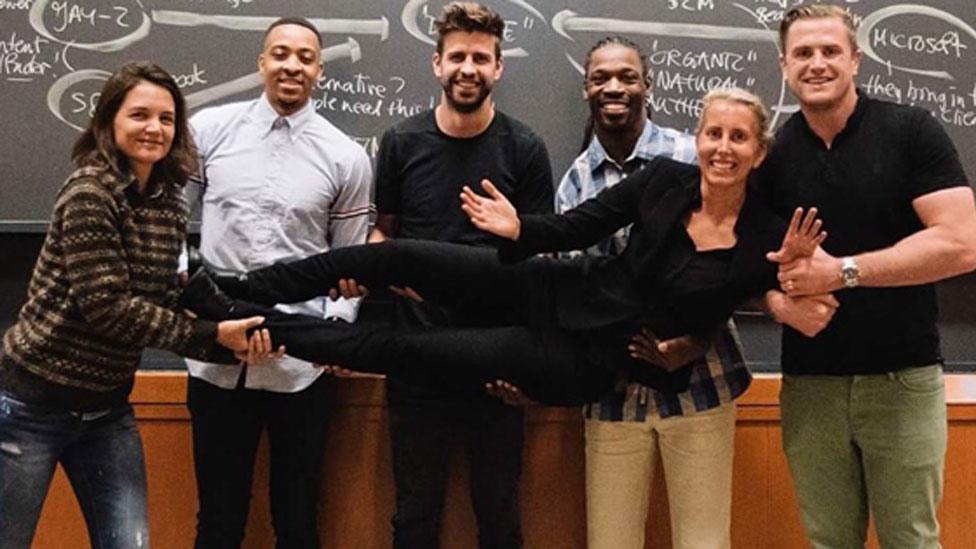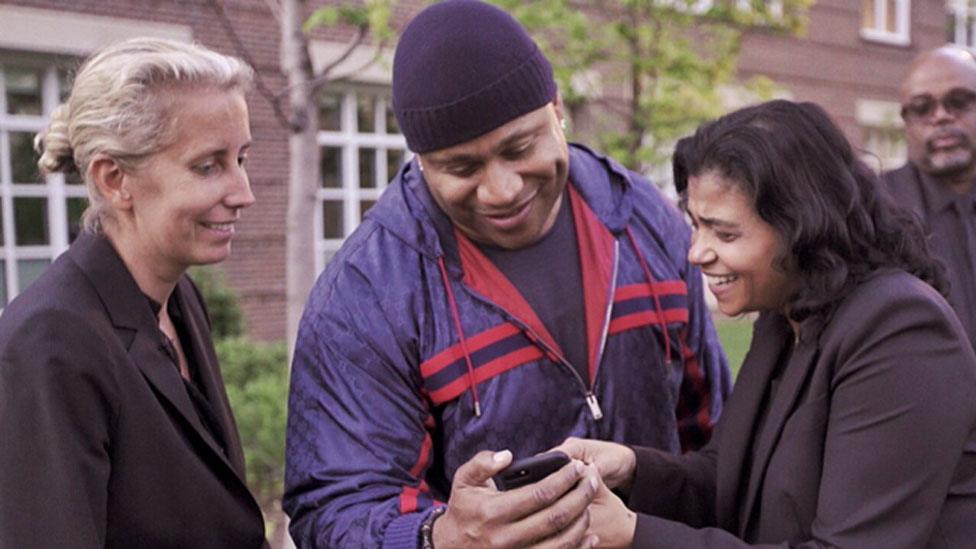Superstars plan next career with Harvard course
- Published

Katie Holmes is among the famous names signing up as students for the Harvard course
The football superstar, the actress and the rapper walk into a classroom.
This is not the set-up for a joke, but a four-day executive education course held at Harvard Business School in the United States last month.
Among the students taking the Business of Sport, Media and Entertainment course were Barcelona defender Gerard Pique, actress Katie Holmes and Irish rugby union player Jamie Heaslip.
Rapper LL Cool J is another former graduate.
"Many of the participants want to know how to monetise their brand and build a business around it, to launch a second career after their current one is over, or to enter new careers," says course leader Professor Anita Elberse.
Prof Elberse's job might sound like a teacher's worst nightmare.
No special treatment
Celebrities are not used to being told what to do - or that they have got something wrong.
But she insists none of them receives special treatment.

Get me a raise: Prof Elberse with actress Katie Holmes and sports stars CJ McCollum, Gerard Pique, Rashean Mathis and Jamie Heaslip
"They know that if they say something that makes no sense, then I or someone else in the class will tell them they are wrong," she says.
"This might actually be quite refreshing for them and one of the reasons they enjoy the course so much."
During the course, they eat meals together and sleep in the Harvard dormitories.
When a celebrity applies to the course, Prof Elberse often phones them up to make sure they know what to expect.
"So far all of them have been very engaged," she says. "I have not been disappointed."
The reason so many big names from sports and entertainment apply for the course is to capitalise on the growing importance of individual superstar brands in these fields.
Betting big
The trend was identified by Prof Elberse in her book, Blockbusters.
She argues that building a business around "blockbuster products" - a small number of high impact, big investment films, TV shows, books or star names - is "the surest path to long-term success".
Barcelona and Real Madrid football clubs are claimed as examples - gaining sporting and commercial success by spending a large proportion of their budgets on a few stars like Cristiano Ronaldo and Neymar Jr.
The rise of the superstar has been accelerated by social media, which allows individuals to connect directly with fans, rather than work through publishers or agents.

Rapper LL Cool J has been a fan of the course at Harvard
Irish rugby union player Jamie Heaslip might have been setting off for New Zealand with the Lions tour last month, but a serious injury in March meant he had time to attend this year's course.
He hopes to apply what he learned to his own sport.
"I was fascinated by the blockbuster theory and how it can be implemented in rugby, which has only been professional for 20 years, so is a relatively young sport in that sense," he says.
"We looked at how other sports have sold themselves as entertainment products, and how everyone involved in a sport is a stakeholder who can have a role in growing the game."
"I had some interesting discussions with [basketball player] C.J. McCollum about the differences between the business side of rugby and the NBA."
He says he would be interested in working to grow rugby in new markets after he retires from playing.
Sporting chances
Prof Elberse's course could have an impact on the future of sport and entertainment, if her students go on to become leaders in these industries.
Gerard Pique has been suggested as a future president of Barcelona. Will he apply the blockbuster theory to running the Spanish club?
"I don't know, but I told him if he's president then I insist on being vice-president," she says.

Ideas for the Global education series? Get in touch.

The course is taught using Harvard Business School's case study method. Students look at 10 recent examples of success and failure in the sports, entertainment and music industries.
These include Beyonce's gamble to release an album in 2013 without any prior marketing and promotion, and the decision by a production company to sell the TV series House of Cards to Netflix rather than a traditional TV network in 2011.
Students are divided into small groups to discuss the case studies, then the groups present their findings to the rest of the class.
"I ask questions and hope they come up with the answers, and I provide models for how they can think about or frame the discussion," says Prof Elberse, who also teaches the MBA at Harvard Business School.
Ultra networking
Jamie Heaslip has an undergraduate degree in medical engineering and a master's in business. He says the case study method was "very different to what I've experienced in my own education" but "very insightful".

Prof Elberse has developed a theory of high impact "blockbuster" successes
This was partly because of the backgrounds of his fellow students - only 10 were from the "talent" side of sport and entertainment and the rest were from the management and business side.
"There were high-up executives running TV companies and studios in the room so it was really interesting to get their perspective," he says.
The course costs $10,000 (£7,700) per head and no prior educational qualifications are required.
With around 60 students attending each year, cynics could say that it is an easy source of income for Harvard.
Prof Dan Sarofian-Butin, dean of the school of education and social policy at Merrimack College in Massachusetts, says the course benefits from Harvard's prestige.
"This type of course allows students to say they went to Harvard, were taught by a famous professor, and interacted with other cool students," he says.
He says most students on executive education courses are already "insiders" who may know more about their industries than a professor.
But he says they can still benefit from the wider view provided by teachers.
"This is what a good teacher can bring to the table - the ability to point things out that are obvious, but only once you are able to see the bigger picture," he says.